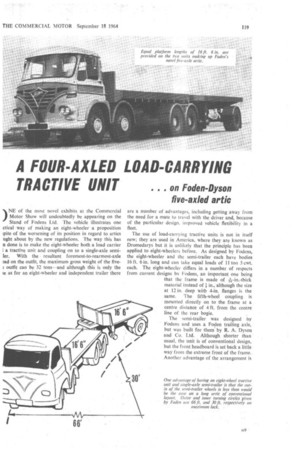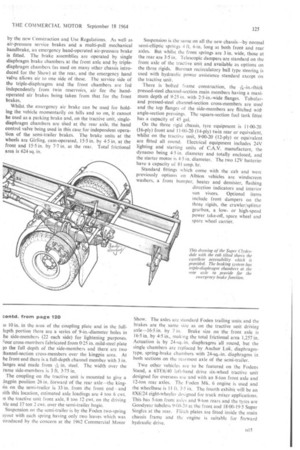FOUR-AXLED LOAD-CARRYING TRACTIVE UNIT
Page 121

Page 122

Page 127

If you've noticed an error in this article please click here to report it so we can fix it.
on Foden-Dyson five-axled artic
)NE of the most novel exhibits at the Commercial Motor Show will undoubtedly be appearing on the Stand of Fodens Ltd. The vehicle illustrates one ctical way of making an eight-wheeler a proposition ipite of the worsening of its position in regard to attics ught about by the new regulations. The way this has n done is to make the eight-wheeler both a load carrier I a tractive unit and coupling on to a single-axle semi
ler. With the resultant foremost-to-rearmost-axle :ad on the outfit, the maximum gross weight of the five: outfit can be 32 tons—and although this is only the ie as for an eight-wheeler and independent trailer there are a number of advantages, including getting away from the need for a mate to travel with the driver and, because of the particular design. improved vehicle flexibility in a fleet.
The use of load-carrying tractive units is not in itself new; they are used in America, where they are known as Dromedarys but it is unlikely that the principle has been applied to eight-wheelers before. As designed by Fodens, the eight-wheeler and the semi-trailer each have bodies 16 ft. 6 in. long and can take equal loads of 11 ton 5 cwt. each. The eight-wheeler differs in a number of respects from current designs by Fodens, an important one being that the frame is made of -&-in.-thick material instead of 1 in.; although the size at 12 in. deep with 4-in, flanges is the same. The fifth-wheel coupling is mounted directly on to the frame at a centre distance of 4 ft. from the centre line of the rear bogie.
The semi-trailer was designed by Fodens and uses a Foden trailing axle, but was built for them by R. A. Dyson and Co. Ltd. Although shorter than usual, the unit is of conventional design, but the front headboard is set back a little way from the extreme front of the frame. Another advantage of the arrangement is that the increase in maximum permitted vehicle length will allow this fairly useful size of semi-trailer to be used and gives reasonable manceuvrability because of the reduced " cut-in " of the outfit. Outer and inner turning circles are given by Fodens as 66 ft. and 30 ft. respectively, against 66 ft. and 19 ft. for a six-wheel tractive unit and tandemaxle semi-trailer running at 32 ton gross, and 66 ft. and 22 ft. for a 30-ton, four-axle artic outfit. But the actual load capacity is only 22 ton 10 cwt. for the eight-wheeler and semi-trailer, against 21 ton 14.5 cwt. for the six-wheeler and semi-trailer and 20 ton 17 cwt. for the four axle outfit. These dimensions are for vehicles having 8-ft. 2'5-in. overall width front axles, which have now been standardized by Fodens with the object of reducing turning circle diameters.
Has 12-speed gearbox
Fodens have given the model designation 8AE7/32 to the unit and the eight-wheeler has the Foden Mk. 7 twostroke diesel engine and is fitted with the Foden reinforced plastics tilt cab. Because of the increased weights now permitted Fodens have decided to re-introduce the 12-speed gearbox. This box consists of a four-speed, constant-mesh main unit with ratios of 618, 3-03, 1.69 and I to I forward and 5.41 to I reverse, and has a three-speed air-operated epicyclic gearbox fitted to the end of its casing. This gives a high range and a low range as well as direct for each of the main ratios. The high ratio is 0.77 and the low 3.29 to 1, and 12 usable ratios forward are in fact provided.
Braking
Braking is by an air-pressure system, and to provide adequate efficiency as required by the new regulations for a second or emergency system, triple-diaphragm brake chambers are used on both front axles of the eight-wheeler tractive unit. The emergency side of these is brought into operation on use of the hand brake, which also operates the usual Foden drum-type transmission brake mounted at the rear of the rearmost axle. Brake units are cam-operated all round, the diameter of the drums being 16.5 in. in all cases and the width of the shoes on the front axles 4.5 in., whilst on the rear bogie and the semi-trailer axle the shoe width is 7 in. All brake chambers are 24 sq. in. and toi frictional area of the outfit is 1,482 sq. in.
It will be seen that the outfit just described is a match one in that the complete design is by Fodens, and the sen trailer will only be supplied for fitting to Foden eigl wheelers. Existing vehicles can be converted and the built within the prescribed time under the new regulatio will be plated for 32 tons gross.
One of the interesting exhibits on Fodens' Stand at t last Commercial Motor Show was a matched artic usi a Dyson semi-trailer. Again a similar vehicle will shown, but in this case the complete design is by Fode with the semi-trailer built by Dyson.
The tractive unit is a Foden 4AE6/30 four-wheeler al the outfit is designed for a gross train weight of 30 toi Wheelbase is 10 ft. and in this case the Foden Mk. 6 engi is used in conjunction with the same 12-speed gearbox in the eight-wheeler. The chassis will also have the Fod tilt cab and an air-pressure braking system with air assi ance on handbrake operation (a transmission brake behii the rear axle) by actuation of triple-diaphragms fitted to t front axle. Front and rear axles have capacities of 5 a. 9 tons respectively and the worm-drive rear axle has a ral of 6-25 to I. Tyre equipment is 10.00-22.5 Michelin tubeless on 6.75 in. rims.
The semi-trailer is 34 ft. long and has I-section sk members measuring 15.625 in. by 5-5625 in. -and made -high-yield steel. The depth of the side-members reduc :o 10 in. in the area of the coupling plate and in the fulliepth portion there are a series of 9-in.-diameter holes in he side-members (22 each side) for lightening purposes. your cross-members fabricated from 0.25 in. mild-steel plate go the full depth of the side-members and there are two ;hannel-section cross-members over the kingpin area. At he front end there is a full-depth channel member with 3 in. langes and made from Ili; in. steel. The width over the rame side-members is 3 ft. 3-75 in.
The coupling on the tractive unit is mounted to give a ingpin position 26 in. forward of the rear axle---the king'in on the semi-trailer is 33 in. from the front end-and vith this location, estimated axle loadings are 4 ton 6 cwt. the tractive unit front axle, 8 ton 12 cwt. on the driving xlc and 17 ton 2 cwt, over the semi-trailer bogie.
Suspension on the semi-trailer is by the Foden two-spring iyout with each spring having only two leaves which was ttroduced by the concern at the 1962 Commercial Motor Show. The axles are standard Foden trailing units and the brakes are the same size as on the tractive unit driving axle-16-5 in. by 7 in. Brake size on the front axle is 16-5 in. by 4.5 in., making the total frictional area 1,257 in. Actuation is by 24-sq.-in, diaphragms all round, but the single chambers are replaced by Anchor Lok, diaphragmtype, spring-brake chambers with 24-sq.-in. diaphragms in both sections on the rearmost axle of the semi-trailer.
Two other vehicles are to be featured on the Fodens Stand, a 6TE6/40 left-hand drive six-wheel tractive unit designed for overseas u,e and with an 8-ton front axle and 12-ton rear axles. The Foden Mk. 6 engine is used and the wheelbase is 11 ft. 3.5 in. The fourth exhibit will be an 8X6/24 eight-wheeler designed for truck mixer applications. This has 5-ton front axles and 9-ton rears and the tyres are Goodyear tubeless 9.00-20 at the front and 18-00-19-5 Super Singles at the rear. Flitch plates are fitted inside the main chassis frame and the engine is suitable for forward hydraulic drive.


































































































































































































































































